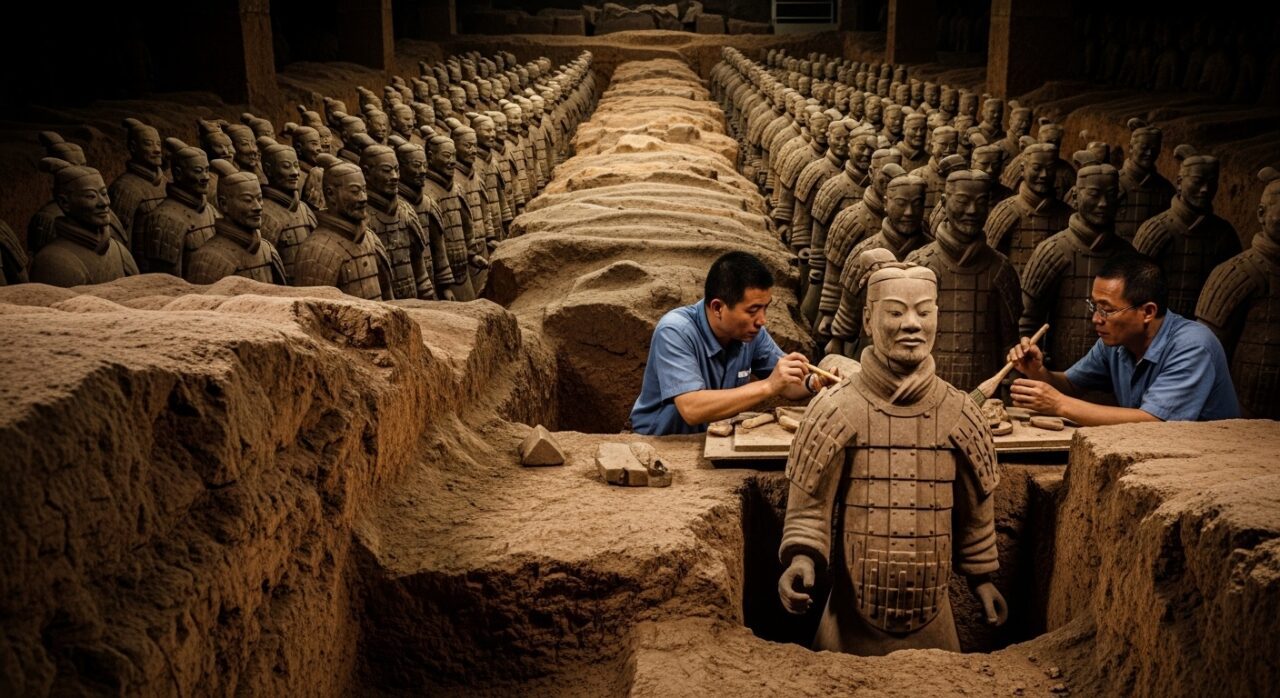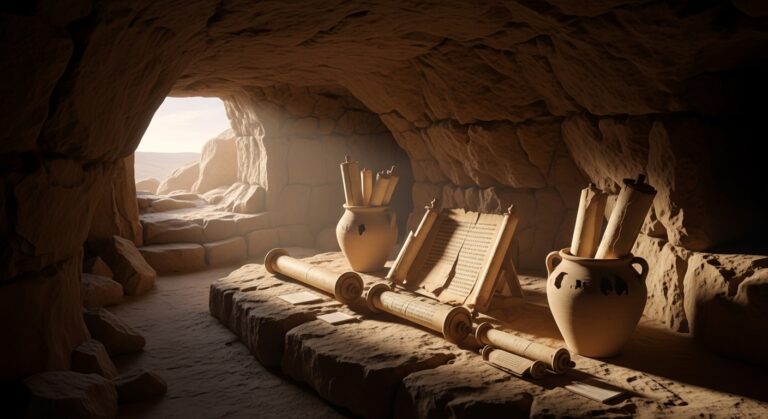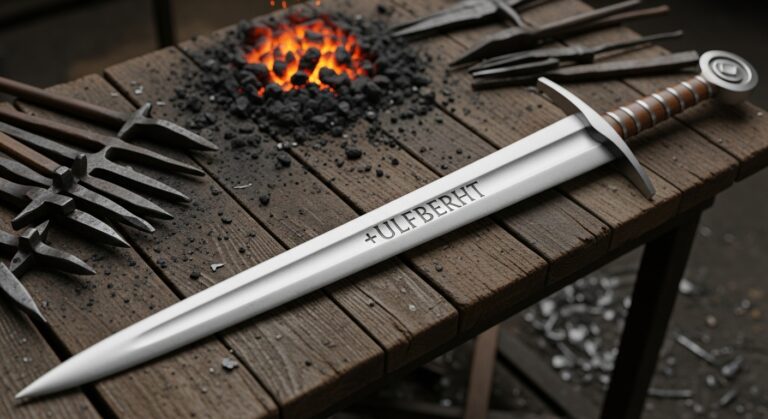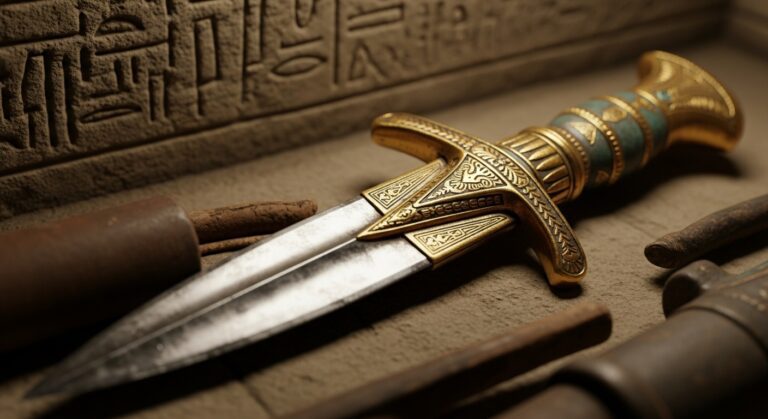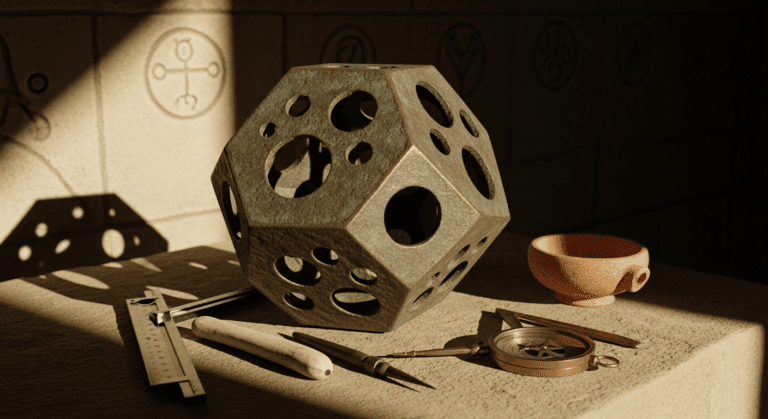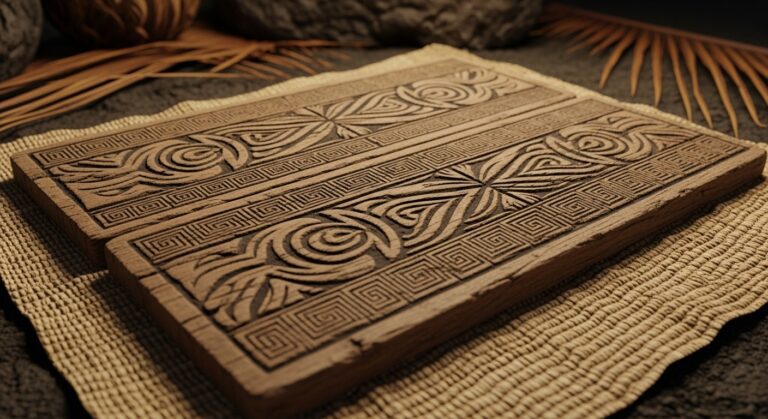Terracotta Army: Secrets Beneath Xi’an
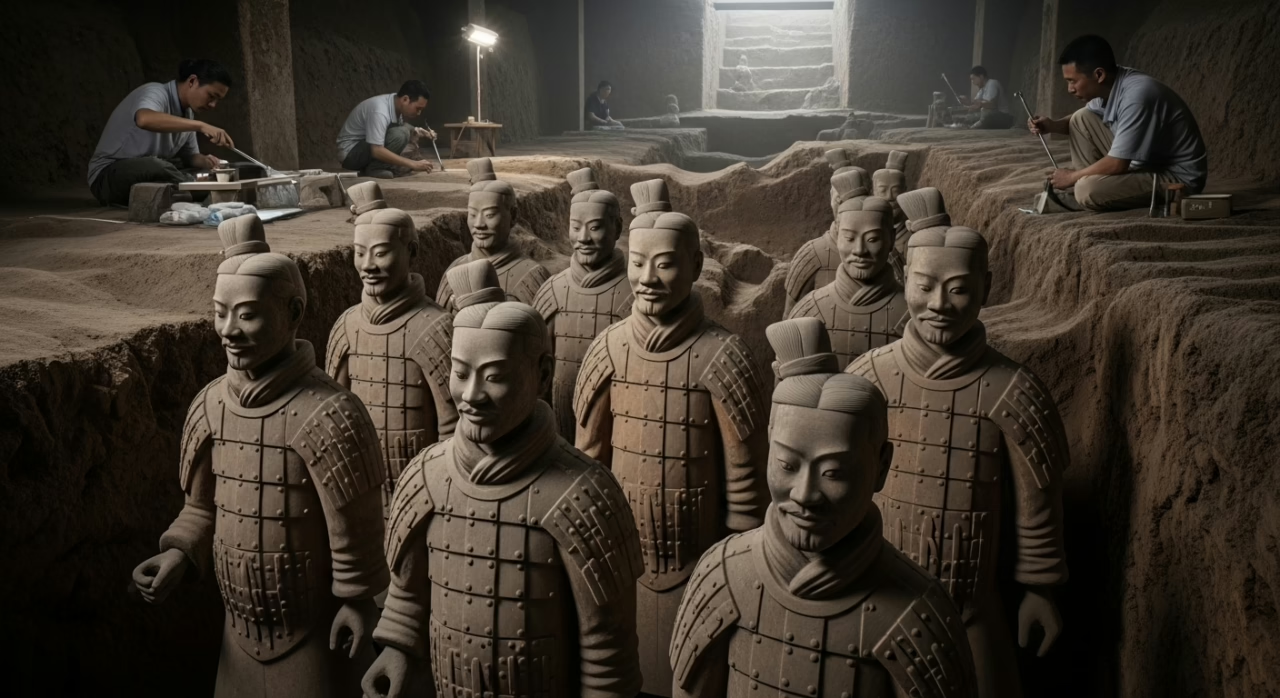
Inside the Secrets of the Terracotta Army – Beneath the loess plains of Xi’an lies an army frozen in time.
The Terracotta Warriors stand in silent formation, each face uniquely carved, each figure positioned according to ancient military doctrine.
Discovered in 1974 by farmers digging wells, these clay sentinels have transformed our understanding of Qin dynasty artistry and imperial ambition.
Yet despite decades of excavation, the most tantalizing secrets remain sealed within Emperor Qin Shi Huang‘s untouched central tomb—what treasures or technologies might still await beneath the soil?
Highlights
Hide- Emperor Qin's actual tomb remains sealed since 210 BCE due to high mercury levels and potential preservation challenges.
- Advanced scanning reveals the underground complex spans nearly 38 square miles with intricate corridors and chambers.
- Each of the 8,000 terracotta warriors has unique facial features, suggesting they may represent actual soldiers.
- Archaeological evidence indicates possible Greek influence on warrior designs, suggesting ancient cultural exchange.
- Warriors originally featured vibrant colors and advanced chrome-plating technology that prevented weapon rust for centuries.
Discovery of the Terracotta Army Beneath the Fields of Xi’an
In 1974, local farmers digging a well near Xi’an stumbled upon one of archaeology’s greatest treasures: thousands of life-sized terracotta warriors buried for over two millennia beneath China’s fertile loess soil.
The discovery, occurring in the midst of ordinary agricultural activity, transformed our understanding of Emperor Qin Shi Huang‘s legacy and revealed an underground complex spanning nearly 38 square miles, complete with intricate corridors, burial chambers, and military formations mirroring ancient Chinese warfare tactics.
What began as several broken clay fragments emerged, through careful excavation and mapping, as an elaborate necropolis—a silent terracotta army arranged in precise battle order, their weapons once real and their purpose eternally fixed on protecting their emperor in the afterlife.
The Accidental Find That Shocked the World
In the spring of 1974, local farmers digging a well near Xi’an in China’s Shaanxi Province unearthed fragments of terracotta figures that would ultimately reveal one of archaeology’s most spectacular discoveries.
What began as routine agricultural work transformed into a watershed moment in archaeological history when experts arrived to investigate the farmers’ curious find, gradually exposing a vast underground complex housing thousands of life-sized clay warriors.
The meticulous excavation that followed revealed an extraordinary tribute to Emperor Qin Shi Huang’s power—an entire terracotta army positioned in battle formation, each soldier uniquely crafted with individual facial features, standing in silent vigil for over two millennia.
Local farmers stumble upon ancient artifacts
While digging a well during the scorching summer of 1974, local farmers in Xi’an’s Lintong District made an archaeological discovery that would forever alter our understanding of ancient Chinese civilization.
Their shovels struck terracotta fragments, remnants of rural heritage once celebrated in local folklore.
The significance of these artifacts, unearthed through ancient farming techniques, would challenge archaeological preservation efforts and captivate the world’s imagination.
How archaeologists uncovered the larger complex around the Terracotta Army
Following the farmers’ accidental discovery, archaeological teams descended upon Lintong District with unprecedented speed. Their systematic approach transformed rural farmland into meticulously gridded excavation sites.
Employing revolutionary archaeological methods, researchers navigated excavation challenges while mindful of historical context and cultural significance.
Innovative preservation techniques allowed this subterranean army to emerge intact, its ranks bearing silent witness to an emperor’s paradoxical fear and ambition.
Mapping the Layout of the Burial Site
The enormous burial complex stretches across nearly 22 square miles, revealing a meticulously planned underground army arranged in military formation—a silent reflection of Emperor Qin’s military might.
Archaeological mapping has uncovered three main pits housing approximately 8,000 soldiers, with infantry positioned in the vanguard, cavalry units stationed along the flanks, and charioteers commanding strategic positions throughout the formation.
Each warrior’s placement follows precise military strategy, creating a subterranean battlefield where rank, specialty, and tactical purpose determined every soldier’s position within this clay regiment that has stood sentinel for over two millennia.
Overview of the pits and formations
Beneath the verdant fields of Xi’an, a sprawling archaeological masterpiece lay undisturbed for over two millennia until its accidental discovery in 1974 by local farmers digging a well.
The burial complex comprises four distinct pit formations, each disclosing sophisticated archaeological layout patterns that mirror ancient military organizational principles.
Modern excavation techniques have disclosed three primary pits containing warriors and one command center, strategically arranged to defend Emperor Qin’s afterlife domain.
Unique placement of infantry, cavalry, and chariots
Strategically arranged across the vast subterranean complex, Emperor Qin’s silent clay army reveals a meticulous military hierarchy through its precise positioning of different warrior types.
The spatial organization mirrors actual battlefield tactical formations, with vanguard infantry positioned forward, cavalry units along the flanks for mobility, and chariot commanders centrally placed—a military strategy with profound burial significance and historical implications for understanding ancient Chinese warfare.
The Craftsmanship of Thousands
Each terracotta warrior, a representation of ancient craftsmanship, bears a unique face sculpted with remarkable attention to detail, from distinctive hairstyles to individualized facial features suggesting these were portraits of actual soldiers.
The artisans responsible for this martial legion equipped their clay sentinels with meticulously crafted weapons and armor—bronze swords that maintained their edge for two millennia, crossbows with working trigger mechanisms, and lamellar armor recreated in clay with historical precision.
Standing in formation, these warriors present themselves as a battle-ready force, their postures and positioning revealing sophisticated military organization that mirrored the actual Qin dynasty army, creating not merely statues but a silent, eternal fighting force prepared for combat in the afterlife.
Artistry Behind Every Warrior’s Face
Every terracotta warrior in Emperor Qin’s vast funerary army exhibits meticulously crafted, distinctive facial features and postures, challenging our modern assumptions about mass production in ancient times.
These individualized characteristics—from almond-shaped eyes and prominent cheekbones to subtle variations in expression and stance—have sparked scholarly debate about whether artisans created idealized soldiers or actually portrayed real individuals from Qin’s military forces.
Archaeological evidence, including fingerprint impressions left in the clay and distinct artistic “signatures” in the craftsmanship, suggests that thousands of skilled artisans worked collaboratively to achieve this extraordinary level of personalization, though the question of whether these faces gazed upon the emperor in life remains tantalizingly unresolved.
Individual facial features and postures
The artisans of ancient China achieved what modern manufacturing still struggles to replicate—genuine individuality on a massive scale.
Each warrior displays distinct facial expressions and posture significance, with pronounced cheekbones, furrowed brows, or contemplative gazes. The sculpting techniques employed reveal remarkable warrior diversity, capturing personalities rather than mere replicas.
This individuality representation suggests a conscious effort to honor the human essence within military uniformity.
Debate on whether they represent real people
Why would artisans invest extraordinary effort creating uniquely detailed faces if not capturing the likenesses of actual individuals?
Scholars remain divided: some contend these warriors represent real identities with historical accuracy, while others view them as artistic interpretations of cultural representation rather than specific soldiers.
The debate touches on individual significance—whether Emperor Qin sought immortalized armies of known warriors or symbolic protectors reflecting his empire’s diverse constituency.
Weapons, Armor, and Battle-Readiness
The Terracotta Army’s arsenal represents an extraordinary technological achievement, featuring over 40,000 bronze weapons including swords, spears, crossbows, and arrowheads that remained remarkably preserved for over two millennia.
Each weapon was crafted as a fully functional armament, complete with intricate chrome-plating technology that prevented rust and corrosion—a metallurgical sophistication that wouldn’t be replicated in Europe until the 18th century.
Archaeological analysis reveals that these weapons were manufactured with standardized precision using assembly-line methods, reflecting the Qin dynasty’s revolutionary military organization which helped Emperor Qin Shi Huang unify China through overwhelming force and technological superiority.
Types of real bronze weapons buried with the army
Gleaming bronze weapons, remarkably preserved despite their two-millennia entombment, constitute one of the most significant archaeological discoveries within Emperor Qin Shi Huang’s terracotta army complex.
The arsenal includes crossbows, swords, spears, halberds, and arrowheads—all exemplifying advanced bronze craftsmanship and military technology.
These artifacts illuminate ancient warfare strategies and burial practices that guaranteed the emperor’s eternal military dominance.
Technological detail hidden within military gear
Beneath the imposing exterior of each terracotta warrior’s battle gear lies an intricate world of technological innovation that has astounded modern researchers since their discovery in 1974.
Advanced weaponry design, from crossbow triggers to arrowheads, reveals hidden technological advancements unprecedented for their era.
The military innovation secrets of the Qin dynasty, illuminated through modern craftsmanship analysis techniques, demonstrate sophisticated armor functionality studies rarely seen in ancient civilizations.
Qin Shi Huang’s Vision of Power
Emperor Qin Shi Huang, whose quest for immortality bordered on obsession, commissioned the terracotta warriors not merely as guardians but as a projection of his imperial might that would transcend death itself.
The scale of this posthumous army—spanning over 14,000 square meters with an estimated 8,000 soldiers, 130 chariots, and 670 horses—required decades of forced labor from countless artisans and workers whose names history has largely forgotten.
Behind the magnificent spectacle lies a sobering reality: these silent sentinels, each with unique facial features and detailed armor, represent both artistic triumph and the immense human cost of one ruler’s determination to rule eternally.
Building an Army for the Afterlife
Emperor Qin Shi Huang, consumed by the ancient Chinese belief that death was merely a passage to another dimension requiring the same protections as life, commissioned his vast terracotta army to stand eternal guard against supernatural threats and rival kingdoms in the afterlife.
His necropolis, a mirror image of his earthly domain complete with warriors, officials, and entertainers, reflected his unrelenting pursuit of immortality through both alchemical elixirs and symbolic representations of power that transcended death itself.
The emperor’s fear of vulnerability beyond the grave consequently manifested in clay and bronze—thousands of individualized soldiers frozen in formation, awaiting commands that would never come, yet embodying the ultimate expression of an autocrat’s refusal to relinquish control even to death’s inevitable embrace.
Why an emperor needed protection after death
While ruling with an iron fist during his life, Qin Shi Huang’s obsession with immortality ultimately manifested in his extraordinary preparation for death, creating a subterranean domain that mirrored his earthly dominion.
The emperor’s beliefs demanded afterlife protection, ensuring spiritual security beyond the grave. This terracotta safeguard represented more than personal defense—it symbolized dynastic continuity and has profound cultural significance in understanding ancient Chinese conceptions of power.
The connection to beliefs about immortality
Beneath the grand obsession with both earthly power and spiritual transcendence lay Qin Shi Huang’s complex vision for eternal existence, a vision that materialized most dramatically in his clay legion.
The emperor’s immortality beliefs merged ancient philosophies with unprecedented imperial ambition, creating a monument where afterlife significance transcended mere burial tradition.
Through spiritual protection and emperor worship, he established a domain where death itself bent to royal will.
Construction Scale and Hidden Labor
Archaeological evidence suggests that over 700,000 laborers toiled for nearly four decades to construct the emperor’s sprawling necropolis, an undertaking of staggering proportions that reveals the absolute power wielded by Qin Shi Huang.
Many workers, including skilled artisans and conscripted laborers, endured brutal conditions and were likely executed after completion to preserve the tomb’s secrets. Their bones discovered in nearby mass graves speak volumes about the human cost of imperial ambition.
The culture of enforced secrecy surrounding the construction was so pervasive that historians still debate numerous aspects of the tomb’s creation, from the technical methods used to mass-produce thousands of unique warriors to the actual location of the emperor’s body, which remains sealed within its mercury-laden chamber.
Estimated number of workers and timeline
Thousands of laborers toiled relentlessly over a span of nearly four decades to create Emperor Qin Shi Huang’s vast underground army, a project of unprecedented scale that began around 246 BCE when the future emperor was merely thirteen years old.
Historians estimate the workforce numbered between 700,000 and one million craftspeople, organized under strict military-style labor hierarchies that reflected the project’s immense historical significance.
Harsh conditions and secrecy around the tomb’s creation
The massive workforce that built Emperor Qin Shi Huang’s terracotta legacy operated under conditions that historians now recognize as brutally oppressive, with evidence suggesting thousands died during the project’s lengthy execution.
Ancient labor practices included protective measures against tomb raiders while enabling mysterious origins and hidden rituals to flourish.
Historical records indicate secretive construction techniques were employed, with workers possibly executed to maintain imperial confidentiality.
What Remains Buried
While visitors marvel at the thousands of unearthed terracotta warriors, Emperor Qin Shi Huang’s actual tomb remains sealed beneath a earthen mound, untouched since its completion in 210 BCE.
Chinese authorities have deliberately postponed full excavation, citing concerns about preservation technology, potential mercury contamination, and respect for cultural heritage.
The unopened burial chamber, described in ancient texts as containing rivers of mercury flowing through miniature landscapes beneath a ceiling mapped with stars, represents both archaeology’s greatest temptation and its most sobering responsibility.
The Unopened Tomb of the Emperor
Historical records from the Shiji chronicle ominous warnings about Emperor Qin’s burial complex, describing mercury rivers, crossbow traps, and labyrinthine passages designed to confound would-be tomb raiders.
Modern geophysical surveys confirm anomalously high mercury concentrations in the soil above the unopened central chamber, lending credence to these ancient accounts that once seemed merely fantastical.
The tomb’s interior, undisturbed for over two millennia, presents archaeologists with an ethical conundrum: whether to penetrate this potentially pristine time capsule or leave the First Emperor to rest among his subterranean palace of treasures that contemporary texts claim “reflects the universe itself.”
Ancient texts warning of traps and mercury
Ancient Chinese texts repeatedly warn of elaborate traps and deadly hazards engineered to protect the final resting place of Emperor Qin Shi Huang, creating an enduring archaeological mystery that persists to this day.
Historical records describe crossbows triggered by intruders, rivers of toxic mercury, and burial traps designed to satisfy the emperor’s fears of the afterlife—ancient warnings that modern scientific testing has partially confirmed.
Scientific scans hinting at what lies beneath
How much do we truly know about the untouched inner chambers of Emperor Qin Shi Huang’s vast necropolis?
Modern scientific methods and archaeological advances now offer tantalizing glimpses through non-invasive imaging technology. Researchers meticulously analyze data interpretation from ground-penetrating radar, revealing possible chambers, corridors, and artifacts.
These historical insights provide freedom to explore without disturbing the emperor’s rest—a balance between knowledge and reverence.
Why Excavation Has Been Delayed
The decision to postpone further excavation of Emperor Qin Shi Huang’s tomb complex stems from legitimate preservation concerns regarding potentially fragile artifacts and unknown materials that might deteriorate upon exposure to air and light.
Chinese archaeological authorities have adopted a cautious approach, respecting both scientific principles and cultural sensitivities surrounding what many consider China’s most significant archaeological site.
Beyond technical challenges, political considerations also influence the timeline, as government officials balance scientific inquiry against the symbolic importance of the first emperor’s final resting place.
They prefer to wait until technologies advance sufficiently to guarantee proper conservation of whatever treasures remain buried beneath centuries of earth and secrecy.
Preservation challenges for unknown materials
Despite significant archaeological interest and global fascination, vast portions of Emperor Qin Shi Huang’s necropolis remain deliberately unexcavated, primarily due to formidable preservation challenges posed by unknown materials within the site.
Archaeologists face intricate conservation challenges when ancient pigments and organic elements immediately deteriorate upon exposure to air.
Current archaeological methods and chemical analysis techniques continue evolving to meet these preservation demands.
Cultural and political reasons for restraint
Beyond technical preservation concerns, powerful cultural and political considerations have greatly influenced China’s measured approach to excavating Emperor Qin’s vast mausoleum complex.
Chinese authorities view the site as both a cultural legacy and reflection of imperial power within its historical context. The carefully controlled excavation pace preserves political symbolism while honoring societal beliefs about the sanctity of ancient burials and the symbolic boundaries between past dynasties and present governance.
Ongoing Mysteries and Modern Tools
The weathered terracotta warriors, whose once-vibrant hues have mostly faded to earthen tones, harbor microscopic traces of pigments that reveal an ancient world far more colorful than what meets the modern eye.
Advanced spectroscopic analysis and high-resolution imaging continue to uncover evidence of sophisticated paint application techniques that would have required remarkable chemical knowledge, challenging our assumptions about ancient technological capabilities.
Perhaps most perplexing among the army’s enduring enigmas are the chrome-plated bronze weapons that exhibit minimal corrosion after two millennia underground, a metallurgical achievement that modern scientists are still struggling to fully comprehend.
Traces of Lost Colors and Vanished Paint
The Terracotta Army warriors, now largely monochromatic clay figures, once paraded in lively hues of vermilion, azure, and emerald that immediately deteriorated upon exposure to air after their excavation.
Modern archaeologists employ cutting-edge spectroscopic analysis and non-invasive imaging techniques to detect microscopic pigment traces, creating digital reconstructions of their original appearance while simultaneously developing new preservation methods.
These conservation efforts represent a race against time, as researchers seek to document and preserve these ephemeral color traces before they vanish completely, taking with them essential insights into the artistic and symbolic dimensions of Emperor Qin Shi Huang’s remarkable funerary monument.
How warriors were once brightly painted
Although modern visitors to the Terracotta Army today observe rows of clay-colored warriors standing in silent formation, these legendary guardians once blazed with bright colors that have largely vanished over two millennia beneath the earth.
- Ancient artisans employed sophisticated preservation methods, applying bright colors over lacquer foundations.
- Each warrior’s palette carried artistic symbolism, with rank denoted through specific pigmentation schemes.
- Cultural significance extended beyond aesthetics, representing imperial authority through ancient techniques.
Current efforts to preserve pigment
While those vivid colors once adorned the Terracotta Army in splendid glory, modern archaeologists face an urgent race against time as remaining pigment fragments deteriorate upon exposure to air and light.
Advanced pigment analysis, utilizing cutting-edge preservation techniques and archaeological methods, now offers hope.
Through modern technology, researchers document existing color traces while developing innovative color restoration protocols that balance scientific inquiry with cultural heritage protection.
Technological Puzzles That Still Confound Experts
The Terracotta Army’s weapons exhibit remarkably advanced metallurgy for the 3rd century BCE, with chrome-plated bronze swords that remained sharp and rust-free for over two millennia, challenging modern understanding of ancient Chinese technological capabilities.
Researchers remain puzzled by the precise techniques employed to achieve such sophisticated metallurgical properties, particularly the anti-corrosion treatments that preserved these weapons in near-pristine condition despite their lengthy burial.
The manufacturing precision evident in these artifacts suggests specialized tools and assembly-line production methods that rival contemporary industrial processes, prompting ongoing investigations into how Qin craftspeople achieved such standardization without modern industrial equipment.
Advanced metallurgy found in weaponry
Shimmering beneath two millennia of undisturbed earth, the weapons of the Terracotta Army have yielded one of archaeology’s most perplexing metallurgical mysteries.
Analysis reveals:
- Bronze alloy compositions containing chromium-rich coatings that prevented rust, anticipating modern military technology evolution by centuries.
- Weapon durability analysis confirming blades remained sharp despite their age.
- Ancient metallurgy techniques suggesting craftsmen possessed knowledge seemingly impossible for their era.
Theories on the tools and techniques used
Beneath layers of archaeological intrigue, a profound technological mystery continues to captivate experts studying Emperor Qin Shi Huang’s silent guardians: how exactly did ancient Chinese artisans create such precise, uniform warriors with the tools available in 210 BCE?
Theories range from assembly-line sculpting processes to specialized ancient techniques.
Tool analysis suggests sophisticated construction methods involving molds and custom implements, challenging our understanding of period burial practices and revealing remarkable standardization despite primitive technology.
Legends, Questions, and Theories of the Terracotta Army
Recent archaeological evidence suggests possible Hellenistic influences on the Terracotta Army’s design, raising profound questions about cultural exchanges between ancient China and the West long before established Silk Road trade.
Beneath the vast imperial complex, ground-penetrating radar has revealed tantalizing anomalies that hint at additional chambers, perhaps containing treasures or revelations about Emperor Qin’s afterlife preparations yet undisturbed by modern hands.
These enduring mysteries continue to fuel scholarly debates and theoretical reconstructions of Qin-dynasty cosmology, challenging researchers to reconcile historical texts with the physical evidence emerging from one of humanity’s most ambitious burial sites.
Did Foreign Influences Shape the Army?
Recent archaeological discoveries have sparked a contentious debate about possible Western influences on the creation of the Terracotta Army, with DNA evidence suggesting interaction between East and West long before the documented Silk Road exchanges.
Artistic techniques employed in crafting the warriors—particularly in their realistic portrayal, dimensional precision, and anatomical accuracy—bear striking similarities to ancient Greek sculptural traditions, challenging long-held assumptions about the isolated development of Chinese art.
These findings have ignited scholarly controversy, as some historians vehemently defend the indigenous Chinese origin of the army’s creation while others propose a provocative theory: that Greek sculptors may have directly trained local artisans at Emperor Qin’s request, potentially rewriting our understanding of ancient cultural exchange.
DNA findings and artistic similarities to the West
Archaeological discoveries in the last two decades have dramatically altered our understanding of the Terracotta Army’s origins, suggesting potential Western influences on what was once thought to be an exclusively Chinese creation.
DNA analysis reveals unexpected cultural exchange patterns across the ancient Silk Road.
- European DNA markers found in Xinjiang dating to Qin Dynasty era
- Artistic techniques showing striking parallels to Greek sculptural traditions
- Evidence of Western craftsmen potentially contributing to ancient Chinese masterpieces
Controversy around contact with ancient Greece
How deeply entangled were the artistic traditions of ancient Greece and Qin Dynasty China?
Evidence of ancient trade routes and cultural exchanges has sparked fierce academic debate. Remarkable artistic similarities in sculpting techniques—particularly in realistic anatomical representation—suggest potential historical connections between these civilizations.
Some scholars propose that foreign influences, transmitted via the nascent Silk Road, reached Xi’an before Western historians traditionally acknowledged meaningful East-West contact.
What Else Lies Beneath the Complex?
Despite decades of exploration, experts estimate that less than one-third of the vast Qin Shi Huang mausoleum complex has been excavated, leaving archaeologists to wonder what treasures and revelations remain hidden beneath the surface.
Tantalizing rumors persist about sealed chambers containing everything from maps of the ancient empire drawn with mercury rivers to the emperor’s actual tomb, protected by elaborate traps and surrounded by precious artifacts.
New satellite imaging and ground-penetrating radar have identified numerous anomalies in the surrounding terrain, suggesting the presence of additional warrior formations, lost palatial structures, and perhaps entirely unknown elements of this ancient necropolis that continue to guard their secrets with remarkable tenacity.
Rumors of other chambers and unexcavated sections
Beyond the known warriors standing in eternal formation, the mysteries of Emperor Qin Shi Huang‘s mausoleum complex deepen considerably when researchers and historians contemplate what remains undiscovered beneath the surrounding earth.
Archaeological speculation includes:
- Unexplored chambers housing imperial treasures
- Hidden artifacts revealing advanced technological knowledge
- Ancient secrets protected by deadly mercury rivers, detected through soil analysis but remaining tantalizingly beyond reach
Satellite imagery and what it suggests
Modern satellite imagery has revolutionized our understanding of Emperor Qin Shi Huang’s mausoleum complex, revealing patterns and anomalies invisible to ground-level investigators for millennia.
Advanced remote sensing techniques have identified geometric formations suggesting additional burial chambers, while historical mapping combined with satellite analysis indicates sophisticated ancient technology in the imperial complex’s layout.
These archaeological implications tantalize researchers, promising undiscovered treasures in Xi’an’s fertile soil.
Wrapping Up
The Terracotta Army stands as an enigmatic portal between worlds, its silent ranks guarding secrets that may never fully yield to modern inquiry.
Like a clay tapestry frozen in time, these warriors continue to captivate archaeologists and visitors alike, their individual faces testifying to ancient craftsmanship while their formation hints at imperial ambitions.
As technology advances, humanity’s relationship with this subterranean wonder evolves, balancing curiosity against reverence for what remains concealed.
- Bagley, R. W. (1999). The earliest Chinese bronzes: Art and archaeology. In M. Loewe & E. L. Shaughnessy (Eds.), The Cambridge history of ancient China (pp. 151–307). Cambridge University Press.
- Barrett, T. H. (2005). Taoism, alchemy, and the quest for immortality in early China. Asian Philosophy, 15(2), 157–172. https://doi.org/10.1080/09552360500122961
- Boardman, J. (2001). The diffusion of Classical art in antiquity. Princeton University Press.
- Chase, W. T. (1994). Ancient coatings on Chinese bronzes. Studies in Conservation, 39(2), 109–118. https://doi.org/10.2307/1506486
- Ledderose, L. (2000). Ten thousand things: Module and mass production in Chinese art. Princeton University Press.
- Li, X. (2011). The meaning and significance of the Terracotta Warriors: A reinterpretation. Asian Perspectives, 50(2), 223–246. https://doi.org/10.1353/asi.2011.0016
- Liu, L. (2007). The Chinese Neolithic: Trajectories to early states. Cambridge University Press.
- Liu, Y., Li, X., & Mei, J. (2014). Early chrome salt production and application in ancient China: Evidence from bronze weapons of the Terracotta Army. Journal of Archaeological Science, 42, 286–291. https://doi.org/10.1016/j.jas.2013.10.016
- Portal, J. (2007). The First Emperor: China’s Terracotta Army. Harvard University Press.
- Rawson, J. (2002). Qin archaeology and the afterlife: Crafting the soul of the empire. Artibus Asiae, 62(2), 273–326. https://doi.org/10.2307/3249963
- Schoenberger, M. (2013). Hidden treasures of Emperor Qin Shi Huang’s tomb: Preservation versus exploration. Museum International, 65(1–4), 86–95. https://doi.org/10.1111/muse.12024
- Silver, C. S., & Xu, T. (2015). Ancient pigment analysis on the Terracotta Army: Spectroscopic methods and conservation concerns. Studies in Conservation, 60(1), 1–12. https://doi.org/10.1179/0039363015Z.000000000123
- Tan, M., & Zhao, H. (2011). The environmental impact of mercury in Emperor Qin Shi Huang’s mausoleum. Environmental Science and Pollution Research, 18(3), 367–372. https://doi.org/10.1007/s11356-010-0377-7
- Wagner, D. B. (2008). Science and civilization in China, Volume 5, Part 13: Mining. Cambridge University Press.
- Yates, R. D. S. (2013). Qin Shi Huang in history and tradition. In M. Loewe (Ed.), Early Chinese empires: Qin and Han (pp. 36–59). Harvard University Press.
